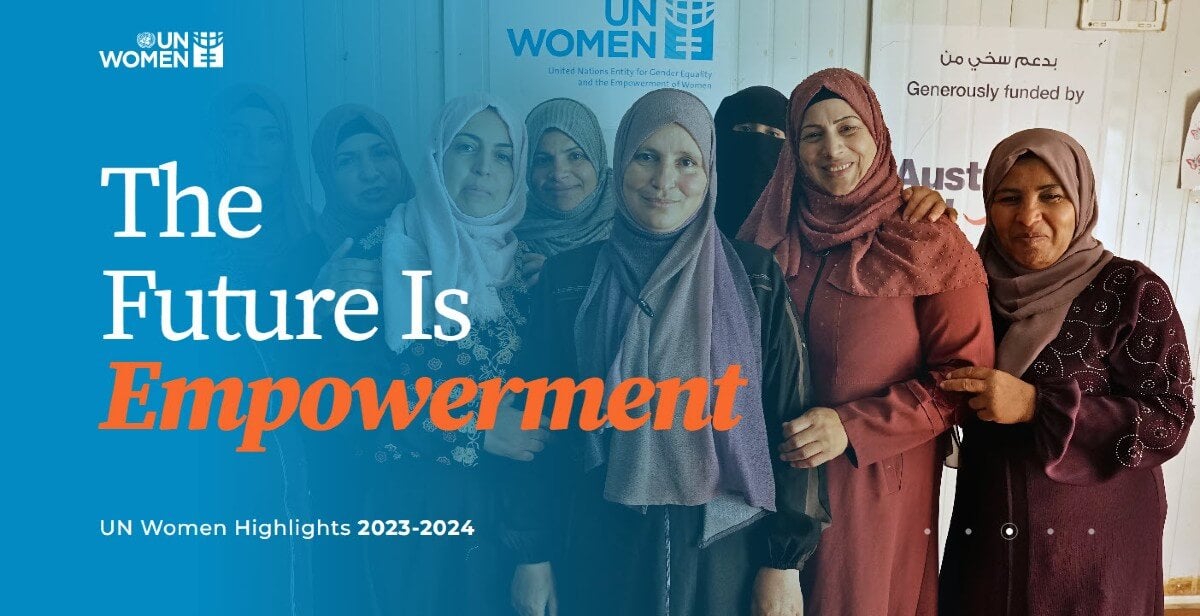Gender equality across the Sustainable Development Goals
-
1 No poverty
Learn moreAt current rates, it will take an additional 137 years to END EXTREME POVERTY among women.
Social protection is key for poverty eradication, yet 50.1% of women are covered by at least one social protection benefit, compared to 54.6% of men
-
2 Zero hunger
Learn moreThere are 47.8 million more moderately or severely food insecure WOMEN than men.
Closing the gender gap in farm productivity and the wage gap in food systems would reduce the number of FOOD-INSECURE PEOPLE by 45 million.
-
3 Good health & well-being
Learn moreCONFLICT and DISPLACEMENT are key risk factors for women’s physical and mental health.
In Sudan, around 1.2 million PREGNANT AND BREASTFEEDING WOMEN are expected to suffer from malnutrition and face complications during delivery.
-
4 Quality education
Learn moreToday, 119.3 million GIRLS remain out of school, down by 5.4 million since 2015.
The annual global cost of the education skills deficit surpasses $10 trillion, more than the GDP of France and Japan combined.
In sub-Saharan Africa, the cost is $210 billion, exceeding 10% of the GDP in this region.
-
5 Gender equality
Learn moreDiscriminatory legal frameworks prevail in many parts of the world.
In 18% of countries, women do not have equal rights to confer citizenship to their spouses and their children.
54% of countries do not have laws that base the legal definition of rape on the lack of freely given consent.
In 51% of countries, there is at least one restriction preventing women from doing the same jobs as men.
72% of countries set the minimum age of marriage below 18 years, with no legal exceptions, for both women and men.
1 in every 8 WOMEN AND GIRLS aged 15-49 was subjected to SEXUAL and/or PHYSICAL VIOLENCE by an intimate partner in the previous year.
Countries with DOMESTIC VIOLENCE LEGISLATION have lower rates of intimate partner violence than those without legislation, 9.5% compared to 16.1%.
18.7% of women aged 20-24 years were married before age 18, down from 24.1% in 2003.
At current rates, CHILD MARRIAGE will only END in 2092.
Globally, women spend 2.5 times as many hours a day on UNPAID CARE and DOMESTIC WORK as men.
In 2023, women held 26.9% of seats in PARLIAMENTS, 35.5% of seats in LOCAL GOVERNMENTS and 27.5% of MANAGERIAL POSITIONS.
Women account for less than 40% of owners or RIGHTSBEARERS for AGRICULTURAL LAND in 32 out of 49 countries with data.
-
6 Clean water & sanitation
Learn moreWOMEN and GIRLS spend 250 million hours per day on water collection.
That is over 3 TIMES MORE than men and boys.
-
7 Affordable & clean energy
Learn moreElectrification increases women’s employment outside the home by 9 to 23 percentage points.
Universal access to clean cooking could save women 40 HOURS A WEEK on average.
-
8 Decent work & economic growth
Learn moreArtificial Intelligence is reshaping labour markets:
3.7% of women hold jobs that could be replaced by the technology, compared to 1.4% of men.
-
9 Industry, innovation & infrastructure
Learn moreWomen account for only 35% of all science, technology, engineering and math graduates.
If left unaddressed, the global gender gap in Internet use could cost low- and middle-income countries an estimated $500 billion over the next five years.
-
10 Reduced inequalities
Learn moreMigrant women and girls are at major risk of gender-based violence and trafficking.
In 2020, women accounted for 64% of detected victims of trafficking for sexual exploitation, and girls for another 27%.
-
11 Sustainable cities & communities
Learn moreIn 2020, only about 6 in 10 urban residents had convenient access to public transportation.
Women rely on such services more than men, making gaps disproportionately worse for them.
-
12 Responsible consumption & production
Learn moreBy 2050, climate change may push up to 158 million more women and girls into extreme poverty ($2.15 per day), 16 million more than men and boys.
At higher poverty thresholds, the total number of women and girls reaches 310 million ($3.65 per day)
And 422 million ($6.85 per day).
-
13 Climate action
Learn moreBy 2050, climate change may push up to 158 million more women and girls into extreme poverty ($2.15 per day), 16 million more than men and boys.
At higher poverty thresholds, the total number of women and girls reaches 310 million ($3.65 per day)
And 422 million ($6.85 per day).
-
14 Life below water
Learn moreBy 2050, climate change may push up to 158 million more women and girls into extreme poverty ($2.15 per day), 16 million more than men and boys.
At higher poverty thresholds, the total number of women and girls reaches 310 million ($3.65 per day)
And 422 million ($6.85 per day).
-
12 Responsible consumption & production
13 Climate action
14 Life below water
15 Life on land
Learn moreBy 2050, climate change may push up to 158 million more women and girls into extreme poverty ($2.15 per day), 16 million more than men and boys.
At higher poverty thresholds, the total number of women and girls reaches 310 million ($3.65 per day) and 422 million ($6.85 per day).
-
16 Peace, justice & strong institutions
Learn moreIn 2023, about 612 million WOMEN and GIRLS lived within 50 kilometres of at least one of 170 armed conflicts, an increase of 41% since 2015.
The United Nations confirmed a 50% increase in cases of conflict-related sexual violence since 2022, with women and girls suffering 95% of these crimes.
-
17 Partnerships for the goals
Learn moreCountries are on average only at a HALFWAY POINT in planning, producing and making gender data available.
Yet half of all projects on statistics and data supported by official development assistance devote less than 0.05% to gender-related dimensions.
Can we achieve gender equality by 2030?
2024 theme
This year's focus is on investing in women's rights as a sure pathway to achieving sustainable development globally.
To achieve this, the United Nations has identified six key investment pathways, known as the Six Transitions, to revitalize the implementation of SDGs. Find out how each transition connects to gender equality.
Make your voice count
Investing in #GenderEquality is about achieving a world where all women and girls are empowered and can enjoy their human rights.
The latest #GenderData suggests that investing in women's rights can unlock immense economic gains for societies.
Join the global movement for gender equality now!
















